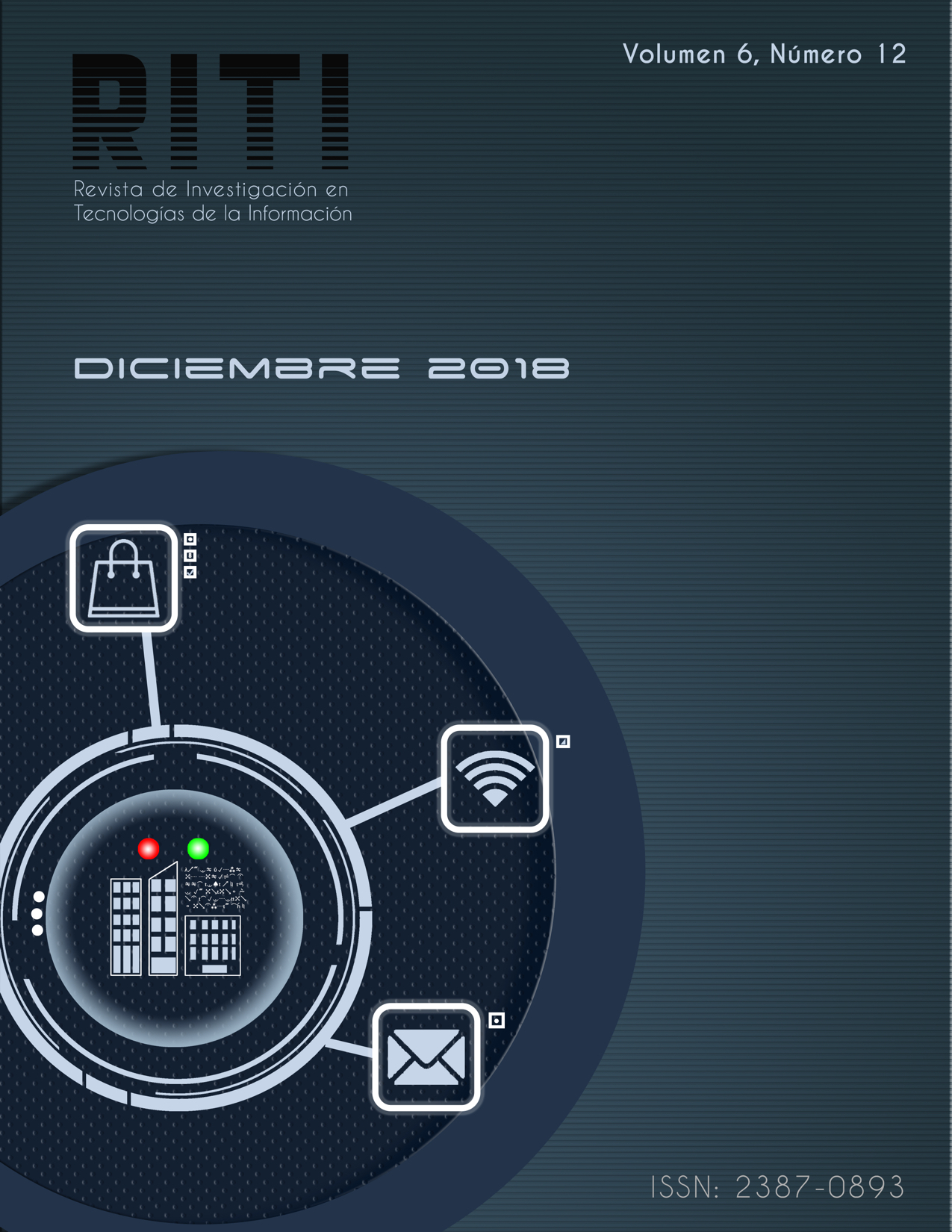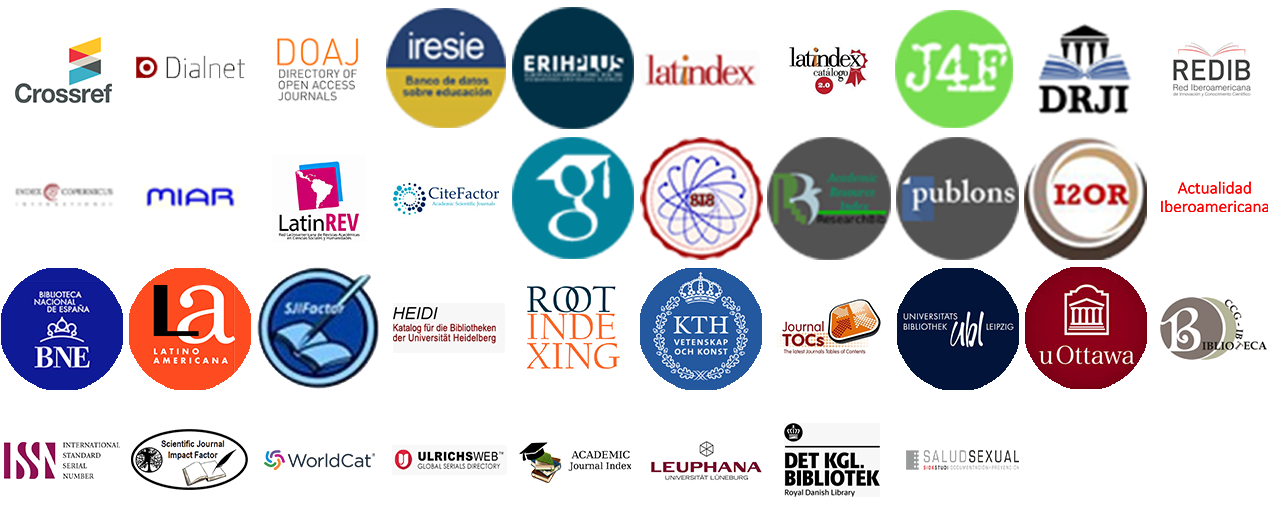AN APPROACH OF CLASSIFICATION OF FACES USING FACIAL ANTHROPOMETRY
DOI:
https://doi.org/10.36825/RITI.06.12.027Keywords:
Age Estimation, Facial Anthropometry, Craniofacial Growth, Fiducial PointsAbstract
The face images processing is one of the study areas within the field of computer vision. Thus there are works mainly in face recognition, emotions identification, among others, however the development of automatic systems of age estimation is a challenge that is still under investigation. In the present work, a procedure to classify a face in a determined age range is proposed. For said proposal, theories of craniofacial growth and facial anthropometry are analyzed, deriving in a selection of anthropometric parameters that represent discriminant characteristics for the distinction of faces at different ages. These parameters were used to generate a classification model on Weka platform using the SVM, Knn, Naïve Bayes and C4.5 algorithms. Cross validation at 10 folds was used for each algorithm. The highest accuracy was obtained with Knn with 7 neighbors and it was 75. 28%. This verifying the usefulness of the anthropometric distances selected for the recognition of age in face images.
References
Rhodes, M. (1995). Age estimation of faces: A review. Applied Cognitive Psychology, 23 (1), 1-12. doi: 10.1002/acp.1442.
Han, H., Otto, C., Jain, A. K. (2013). Age estimation from face images: Human vs. machine performance. The 6th IAPR International Conference on Biometrics (ICB), Madrid, Spain.
Wang, S., Zhou, C., Sun, M, Chen, H., Liu, X., Peng, X. (2011). Can estimate age range using’a face person?. Journal of Computational Information Systems, 7 (13), 4586-4593.
Farkas, L. (1994) Anthropometry of the head and face. (2da. Ed.) New York: Raven Press.
Cootes, T. F., Taylor, C. J., Cooper, D. H., Graham, J. (1995). Active shape models-their training and application. Computer vision and image understanding, 61 (1), 38-59. doi: https://doi.org/10.1006/cviu.1995.1004
Mejía-Molina, N. (2013). Modelos deformables. [versión electrónica] Maestría en Ingeniería de Sistemas y Computación, Pontificia Universidad Javeriana. Recuperado de: http://pegasus.javeriana.edu.co/~PI131-05-DefModMedicos/Documentos/MISyC%20TG%20-%20EstadoDelArte%20-%20%20Nadia%20Mejia%20-%202013-05-24.pdf
Xu, C., Pham, D. L., Prince, J. L. (2000). Image Segmentation Using Deformable Models. En Fitzpatrick, J. M, Sonka, M (Eds.), Handbook of Medical Imaging, Volume 2: Medical Image Processing and Analysis (pp. 129-174) SPIE Press.
Milborrow, S. (2016). Multiview Active Shape Models with SIFT Descriptors. (Tesis Doctoral). Faculty of Engineering, University of Cape Town.
Iqtait, M., Mohamad, F. S, Mamat, M. (2018). Feature extraction for face recognition via Active Shape Model (ASM) and Active Appearance Model (AAM). IOP Conf. Series: Materials Science and Engineering, 332 (012032), 1-8. doi:10.1088/1757-899X/332/1/012032.
Milborrow, S., Nicolls, F. (2014). Active shape models with SIFT descriptors and MARS. Proceedings of the IEEE International Conference on Computer Vision Theory and Applications (VISAPP), (pp. 380-387). Lisbon, Portugal.
Wang, N., Gao, X., Tao, D., Yang, H., Li, X. (2017). Facial feature point detection: A comprehensive survey. Neurocomputing. Journal Neurocomputing, 275 (C), 50-65.
FG-NET Aging Database, (2002). Homepage. Computer Vision for Human-Computer Interaction Lab. Recuperado de: http://yanweifu.github.io/FG_NET_data/FGNET.zip
Caple, J., Stephan, C. N. (2016). A standardized nomenclature for craniofacial and facial anthropometry. International Journal of legal medicine, 130 (3), 863-879.
Dooley, M. (1982). Anthropometric modeling programs-A survey. IEEE Computer Graphics and Applications, 2, 17-25.
Zhuang, Z., Landsittel, D., Benson, S., Roberge, R., Shaffer, R. (2010). Facial anthropometric differences among gender, ethnicity, and age groups. Annals of occupational hygiene, 54 (4), 391-402.
Ramanathan, N., Chellappa, R. (2006). Modeling age progression in young faces. Proceedings IEEE Computer Society Conference on Computer Vision and Pattern Recognition, (pp. 387-394), New York, USA.
Jahanbin, A., Mahdavishahri, N., Baghayeripour, M., Esmaily, H., Eslami, N. (2012), Evaluation of facial anthropometric parameters in 11–17-year-old boys. Journal of Clinical Pediatric Dentistry, 37 (1), 95-101.
Colmenares-Guillen, L. E., Martínez Cruz, A. E., Albores Velasco, F. J., Pérez de Celis Herrero, M. C. (2016). Algorithm approach of a classifier based on aging wrinkle analysis. International Journal of Innovation and Applied Studies, 18 (1), 1-11.
Otaño Lugo, R., Otaño Laffitte, G., Fernández Ysla, R., (2009). Crecimiento y Desarrollo Craneofacial. 1-32. Recuperado de: http://articulos.sld.cu/ortodoncia/files/2009/12/crec-y-des-preg.pdf
Sokolova, M., Lapalme, G. (2009). A systematic analysis of performance measures for classification tasks. Information Processing & Management, 45 (4), 427-437.
Weka 3: Data Mining Software in Java. Recuperado de: https://www.cs.waikato.ac.nz/ml/weka
Hernández O., Ramírez, Q., Ferri, R. (2004). Introducción a la minería de datos. (1a ed.). Madrid: Pearson educación.
Zamorano Ruiz, J. Comparativa y análisis de algoritmos de aprendizaje automático para la predicción del tipo predominante de cubierta arbórea. (Trabajo Fin Máster). Ingeniería de Computadores, Facultad de Informática departamento de sistemas informáticos y Computación. Universidad Complutense de Madrid. Recuperado de: https://eprints.ucm.es/48800/1/Memoria%20TFM%20Machine%20Learning_Juan_Zamorano_para_difundir%20%282%29.pdf
Published
How to Cite
Issue
Section
License
Copyright (c) 2018 Revista de Investigación en Tecnologías de la Información

This work is licensed under a Creative Commons Attribution-NonCommercial 4.0 International License.
Esta revista proporciona un acceso abierto a su contenido, basado en el principio de que ofrecer al público un acceso libre a las investigaciones ayuda a un mayor intercambio global del conocimiento.
El texto publicado en la Revista de Investigación en Tecnologías de la Información (RITI) se distribuye bajo la licencia Creative Commons (CC BY-NC
 ), que permite a terceros utilizar lo publicado citando a los autores del trabajo y a RITI, pero sin hacer uso del material con propósitos comerciales.
), que permite a terceros utilizar lo publicado citando a los autores del trabajo y a RITI, pero sin hacer uso del material con propósitos comerciales.



